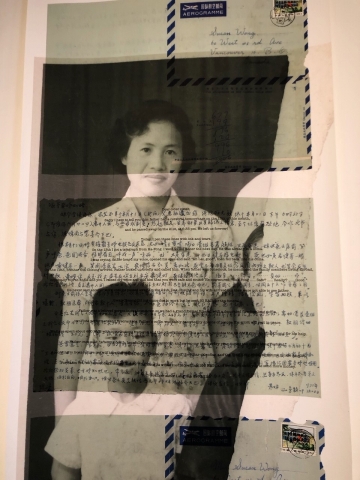淑芳你好嘛Suk-Fong Nay Ho Mah/Suk-Fong, How Are You?

Nestled within Dr. Sun Yat-Sen Garden, Paul Wong's Suk-Fong Nay Ho Mah (2019) immediately exudes a warm intimacy. The exhibition's opening on January 12th attracted a typical Saturday crowd to the Chinatown hallmark: tourists, families, and artists congregated within its rooms as sunlight peeked through the wood-paneled doors. Chatter is near constant, friendly; sipping on small paper cups of tea, visitors murmured between themselves and with each other. With no one but my phone, I nonetheless found myself a welcome guest amidst a gathering of familiars.
淑芳你好嘛Suk-Fong Nay Ho Mah/Suk-Fong, How Are You? is the final installment of Chinese-Canadian artist Paul Wong's year-long residency at the Garden, beginning in April 2018. Wong's late mother, Suk-Fong Wong, serves as both the inspiration and the subject of this exhibition; through the intimate collection of photos, objects, video, and neon work, Wong presents a loving retrospective of the life and experiences of a remarkable woman.
Wong's installation is stirring in the way which diasporic art often is: a bridge between the body-of-work, the body, and the body politic. Two interrelated themes lie central to this exhibition—Suk-Fong's jars of herbal medicine and her collection of letters. A lifetime rests within these mundane objects—the paper and the cupboard—one where the personal is inextricable from the political.
The display of Suk-Fong's precious collection of Chinese herbal medicine is meticulous. This spans a variety of media: a video recording of Suk-Fong fondly speaking about her cupboard collection, which viewers can watch while sitting on ceramic stools; a series of photographic prints showcasing the homemade elixirs, consisting of a variety of flora and fauna stuffed into Kraft mayonnaise jars and coffee tins; a physical display of said containers sprawled across a table, enclosed in glass.
More striking are the letters. Wong highlights four letter-writers: Suk-Fong's father, youngest sister, brother, and niece. These letters are displayed like traditional Chinese scrolls, hung on the wall or across a table, blown up and superimposed with old photos, envelopes, and lines of translation. The resulting dense, lushly overlapping imagery is an immediately arresting cypher: these letters mostly detail the health of family members under Communist China and beyond, but a world remains between the untranslated and the untranslatable.
Two vitrines hold a collection of over 700 letters and envelops from over 90 different writers, spanning across six decades. Unlike the scrolls, these are nearly all unopened, bundled with twine, and hermetically sealed off; what remains visible to the viewers are the various stamps and neat handwriting of the senders. One can only guess what they contain.
There's something else here, beyond all of this. Attending this exhibition in the rapidly gentrifying Chinatown (and a rapidly changing world), I couldn't help but feel a tinge of longing. Paul Wong has presented threads of a journey: between art and culture, the personal and the political, and across a diaspora. History only hurtles forward, and people will never cease to move, but fewer and fewer marks of these particular journeys remain. Hovering over the bundle of letters, I overheard a passing conversation between two visitors: "A lost art", one remarked wistfully. Maybe that is true. But whether it is paper, canvas, video, or glass, Paul Wong has captured that lost world made into flesh, if only for a moment.
